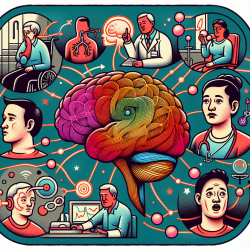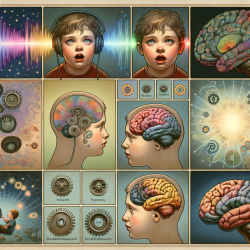Introduction
In the realm of speech-language pathology, the quest for effective therapeutic interventions is ceaseless. A recent study titled "Using in vivo functional and structural connectivity to predict chronic stroke aphasia deficits" offers a promising avenue for enhancing our understanding and treatment of aphasia, a common consequence of stroke. This blog explores how practitioners can leverage these findings to refine their therapeutic approaches and encourages further research in this domain.
Understanding the Study
The study conducted by Zhao et al. delves into the neural underpinnings of aphasia by examining both functional and structural connectivity in the brain. By utilizing advanced neuroimaging techniques, the researchers aimed to predict language-cognitive deficits in patients with chronic post-stroke aphasia. Their findings revealed that while both functional and structural connectivity can predict certain language components, they do not significantly outperform traditional lesion models in explaining deficits.
Key Findings and Implications
- Functional and Structural Connectivity: The study highlighted that connectivity models could predict phonology, semantics, and fluency, but not executive function. This suggests that connectivity insights are valuable, yet not comprehensive, in understanding aphasia deficits.
- Lesion Models: Traditional lesion models, which focus on the site of brain damage, remain highly predictive of language impairment, indicating their continued relevance in clinical settings.
- Network-Level Insights: The study found that functional connectivity features were aligned with resting-state networks in healthy controls, suggesting a potential for network-level reorganization post-stroke.
Practical Applications for Practitioners
For practitioners, these findings underscore the importance of a multifaceted approach to therapy. While lesion models provide a strong foundation, incorporating insights from connectivity studies can offer a more nuanced understanding of a patient's deficits. Here are some practical steps to consider:
- Integrate Connectivity Insights: Use connectivity data to identify potential areas of reorganization and tailor therapy to target these networks.
- Focus on Comprehensive Assessment: Employ a combination of lesion and connectivity assessments to gain a holistic view of the patient's condition.
- Encourage Collaborative Research: Engage in or support research that further explores the integration of connectivity insights into therapeutic practices.
Encouraging Further Research
While the study provides valuable insights, it also highlights the need for further research. Future studies should aim to optimize connectivity models and explore their potential in predicting recovery trajectories. Practitioners are encouraged to collaborate with researchers to contribute to this evolving field.
Conclusion
Incorporating connectivity insights into aphasia therapy represents a promising frontier in speech-language pathology. By embracing a data-driven approach and fostering collaborative research, practitioners can enhance therapeutic outcomes for children and adults alike. To delve deeper into the original research, please follow this link: Using in vivo functional and structural connectivity to predict chronic stroke aphasia deficits.










